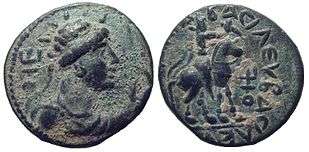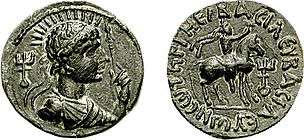Vima Takto
| Vima Takto | |
|---|---|
| Kushan emperor | |
 Bronze coin of Vima Takto, alias "Soter Megas" (r. c. 80–90 CE). Obv: Bust of Vima Takto, with Greek royal headband and radiate, holding sceptre; three-pronged tamgha behind. | |
| Reign | 80–90 CE |
| Predecessor | Kujula Kadphises |
| Successor | Vima Kadphises |
| House | Kushan |
Vima Takto or Vima Taktu was a Kushan emperor who reigned c. 80–90 CE.
Rule
Vima Takto was long known as "The nameless King", since his coins only showed the legend "The King of Kings, Great Saviour", until the discovery of the Rabatak inscription helped connect his name with the title on the coins.
Vima Takto's empire covered northwestern Gandhara and greater Bactria towards China, where Kushan presence has been asserted in the Tarim Basin. Under his reign, embassies were also sent to the Chinese court.
Genealogy
He is mentioned in the Chinese Historical Chronicle of the Hou Hanshu, in relation to his father Kujula Kadphises:
"Qiujiuque (Ch: 丘就卻) [Kujula Kadphises] was more than eighty years old when he died. His son, Yangaozhen (Ch:閻高珍) [probably Vema Tahk(tu) or, possibly, his brother Sadaṣkaṇa], became king in his place. He defeated Tianzhu [North-western India] and installed Generals to supervise and lead it. The Yuezhi then became extremely rich. All the kingdoms call [their king] the Guishuang [Kushan] king, but the Han call them by their original name, Da Yuezhi."[1]
The connection of Vima Takto with other Kushan rulers is described in the Rabatak inscription, which was written by Kanishka. Kanishka makes the list of the kings who ruled up to his time: Kujula Kadphises as his great-grandfather, Vima Takto as his grandfather, Vima Kadphises as his father, and himself Kanishka:
"... for King Kujula Kadphises (his) great grandfather, and for King Vima Taktu (his) grandfather, and for King Vima Kadphises (his) father, and *also for himself, King Kanishka" (Cribb and Sims-Williams 1995/6: 80)
A later inscription found at Vima's sanctuary at Mat, also records that he was the grandfather of Huvishka.
| Preceded by Kujula Kadphises |
Kushan Ruler 80 – 90 CE |
Succeeded by Vima Kadphises |


Footnotes
- ↑ Hill (2009), p. 29; also note 13.16, p. 351, and Appendix O, p. 608.
References
- Falk, Harry 2009. The name of Vema Takhtu. W. Sundermann, A. Hintze & F. de Blois (eds.), Exegisti monumenta - Festschrift in Honour of Nicholas Sims-Williams (Iranica, 17). Wiesbaden : Harrassowitz, pp. 105–116.
- Hill, John E. (2009) Through the Jade Gate to Rome: A Study of the Silk Routes during the Later Han Dynasty, 1st to 2nd Centuries CE. BookSurge, Charleston, South Carolina. ISBN 978-1-4392-2134-1.
- Shrava, Satya (1985) The Kushana Numismatics, p 94.
External links
- Coins of Vima Takto
- Hill, John E. 2004. The Western Regions according to the Hou Hanshu. Draft annotated English translation.
| Kushan Empire Emperors, territories and chronology | ||||||||||||
| Territories/ dates | Western India | Western Pakistan Balochistan | Paropamisadae Arachosia | Bajaur | Gandhara | Western Punjab | Eastern Punjab | Mathura | Pataliputra | |||
|---|---|---|---|---|---|---|---|---|---|---|---|---|
| INDO-SCYTHIAN KINGDOM | INDO-GREEK KINGDOM | Indo-Scythian Northern Satraps | ||||||||||
| 25 BCE – 10 CE | Indo-Scythian dynasty of the APRACHARAJAS Vijayamitra (ruled 12 BCE - 15 CE)[1] |
Liaka Kusulaka Patika Kusulaka Zeionises |
Kharahostes (ruled 10 BCE– 10 CE)[2] Mujatria |
Strato II and Strato III | Hagana | |||||||
| 10-20CE | INDO-PARTHIAN KINGDOM Gondophares |
Indravasu | INDO-PARTHIAN KINGDOM Gondophares |
Rajuvula | ||||||||
| 20-30 CE | Ubouzanes Pakores |
Vispavarma (ruled c.0-20 CE)[3] |
Sarpedones | Bhadayasa | Sodasa | |||||||
| 30-40 CE | KUSHAN EMPIRE Kujula Kadphises |
Indravarma | Abdagases | ... | ... | |||||||
| 40-45 CE | Aspavarma | Gadana | ... | ... | ||||||||
| 45-50 CE | Sasan | Sases | ... | ... | ||||||||
| 50-75 CE | ... | ... | ||||||||||
| 75-100 CE | Indo-Scythian dynasty of the WESTERN SATRAPS Chastana |
Vima Takto | ... | ... | ||||||||
| 100-120 CE | Abhiraka | Vima Kadphises | ... | ... | ||||||||
| 120 CE | Bhumaka Nahapana |
PARATARAJAS Yolamira |
Kanishka I | Great Satrap Kharapallana and Satrap Vanaspara for Kanishka I | ||||||||
| 130-230 CE |
Jayadaman |
Bagamira |
Vāsishka (c. 140 – c. 160) | |||||||||
| 230-280 CE |
Samghadaman |
Miratakhma |
INDO-SASANIANS |
Kanishka II (c. 230 – 240) |
||||||||
| 280-300 | Bhratadarman | Datayola II |
Hormizd II, "Kushanshah" (c. 295 – 300) |
Vasudeva II (c. 275 – 310) | ||||||||
| 300-320 CE |
Visvasena |
Peroz II, "Kushanshah" (c. 300 – 325) |
Vasudeva III |
|||||||||
| 320-388 CE |
Yasodaman II |
Shapur II Sassanid king and "Kushanshah" (c. 325) |
||||||||||
| 388-396 CE | Rudrasimha III | Chandragupta II | ||||||||||
- ↑ From the dated inscription on the Rukhana reliquary
- ↑ An Inscribed Silver Buddhist Reliquary of the Time of King Kharaosta and Prince Indravarman, Richard Salomon, Journal of the American Oriental Society, Vol. 116, No. 3 (Jul. - Sep., 1996), pp. 442
- ↑ A Kharosthī Reliquary Inscription of the Time of the Apraca Prince Visnuvarma, by Richard Salomon, South Asian Studies 11 1995, Pages 27-32, Published online: 09 Aug 2010